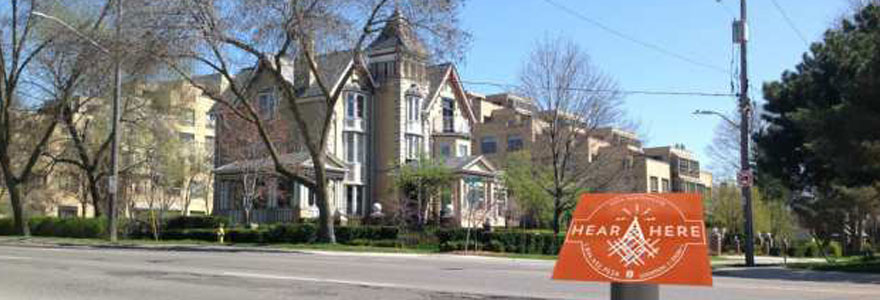News and Updates
Contact
Faculty of Social Science
Social Science Centre
Room 9438
Western University
T. 519-661-2053
F. 519-661-3868
E. social-science@uwo.ca
‘Hear, Here’ dials up history around city
June 05, 2018
Story by Adela Talbot/Western News
This is the driving force behind her latest project.
Hear, Here will collect stories of London’s past and deliver them in bite-size audio clips associated with historical and cultural sites around the city. Sign posts by each site will provide visitors with a number to call and a story to connect them to the spot on which they stand.
“There is an immediacy to it; you’re standing in the spot where something happened, calling in and listening to someone that used to live there talk about it. That’s different than looking at a website or a photo,” said Michelle Hamilton, Director of Western’s Public History program.
Inspired by an initiative at the University of Wisconsin-La Crosse, the project is currently in its first phase, in partnership with Public History postdoctoral scholar Mark Tovey. Tovey has already completed an oral history project interviewing and recording residents of London’s historic St. George-Grosvenor-Piccadilly neighbourhood. His interviews will be used for the first 10 posts and associated audio clips of Hear, Here.
While Tovey hopes to see the first phase completed soon, Hamilton’s incoming students will take up a second phase in September, gathering stories in London’s historic SoHo (south of Horton) neighbourhood. “One of the project goals and objectives is to look at the history of marginalized peoples. A lot of those people live in areas that are gentrifying,” Hamilton noted.
SoHo has a rich history. In the 1860s, it was the end of the Underground Railroad. Later, it was the site of manufacturing in the city, being close to the Thames River, and also housed many immigrant populations over the years.
Because the neighbourhood is gentrifying, a lot of their buildings are being lost. This project could serve as a marker of what could be lost by saying, ‘This building is significant.’ Or the it could serve as a marker of what was lost, like in the SoHo district, where the old Victoria Hospital is being knocked down and others are being discussed for redevelopment reasons, Hamilton said.
“Once you lose the building, you often lose the story that goes with it. In some ways, this project is about preserving stories that otherwise might get lost.”
Having already met with members of the SoHo community about the project, Hamilton said there is much enthusiasm to back the students’ work. A strong core of advocates in the area are worried about heritage buildings, what development might look and what City Hall is planning to do with the land around the old hospital and river. It’s a solid community that sees itself as a neighborhood and stories hold a neighborhood together, Hamilton stressed.
There will be an associated website for the project, Tovey added, along with video content. Individuals who dial in to hear the story of any particular site will also be prompted to share their story, if they have one.
“This is public-facing; you don’t have to know there is a website. You see the post in the community. The website is on there (the post) and you could go to it, but you could also call the phone number. There’s an immediacy to it. People don’t require any technological literacy to dial a phone number. It democracies the access. It means folks of all demographics will be able to access the story,” he explained.
London’s Hear, Here will be supported by UW-La Crosse professor Ariel Beaujot, a native Londoner, who spearheaded the original initiative. Hamilton has invited Beaujot to help get Hear, Here off the ground in London.
“When I started the project in La Crosse, I first asked my students to go to any location and find a story that was of interest to (them). Then, I asked them to find stories from historically underrepresented groups,” Beaujot said. People from 48 states have called to hear the stories associated with dozens of sites around the western Wisconsin river city.
Beaujot continued, “Bringing marginal voices to the fore allows a community to look at itself and see itself differently, to see what they were, what they are now, and what they could or should be. Public history doesn’t only bring important stories to the public; it does something about them after bringing it to the fore.
“There’s social justice work potential. That’s why SoHo is such an important neighborhood. I suspect it was initiated as a poor neighbourhood and now we are trying to gentrify it. Looking at the trajectory and history will help us understand it. I don’t think it’s a good idea to get rid of the ‘unfavourable’ elements of a neighbourhood. It needs a lot of critical-thinking so we don’t do a disservice to the community.”
While on her sabbatical at Western, Beaujot will be working on a book, Comfortable Lies, Uncomfortable Truths: Public History, Private Memory and Race in North American Cities.
London’s Hear, Here will be funded, in part, by the city’s culture office. Hamilton is applying for a Social Sciences and Humanities Research Council (SSHRC) grant to help fund its second phase, launched April 2019.
A project brochure will be produced to be distributed through Tourism London.

